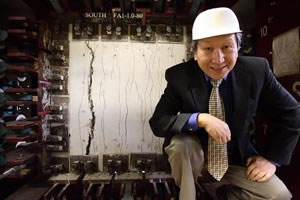Thomas Hsu developed the most advanced machine in the world capable of testing full-size reinforced concrete panels under earthquake-like conditions.
Thomas Hsu, the John and Rebecca Moores Professor of Civil Engineering at the University of Houston Cullen College of Engineering, has received the Arthur J. Boase Award from the American Concrete Institute (ACI).
The award recognizes a person, persons or group for achievement in the field of reinforced concrete research. It is one of only two awards presented by the ACI’s Concrete Research Council and is given out once a year at most. Hsu will accept the award this April at the ACI’s annual conference in Atlanta.
A professor at the University of Houston for the past 27 years, this is the most recent in a series of many honors for Hsu. He is a fellow in the ACI, a recipient of the Wason Medal for Noteworthy Research and the Arthur R. Anderson Award for Research, both from the ACI.
Though he has conducted research in multiple areas, since 1986 the focus of Hsu’s work has been research conducted with a piece of equipment dubbed the “Universal Element Tester” (UET). Housed on the UH campus in the Thomas Hsu Structural Research Laboratory, this instrument is distinguished by its unique capability to test large panel elements under varied controlled forces. The data from these element tests can be integrated by computer techniques to predict the behavior of whole structures when threatened by real-life destructive forces.
Designed and assembled by Hsu, his colleagues and graduate students, the UET uses 40 jacks each capable of applying 100 tons of force to test the strength of element panels of steel-reinforced concrete.
Seen in person, the UET is an impressive piece of equipment. It stands at more than 15 feet tall, weighs almost 40 tons, and contains more than a mile of pipes to transport oil pressure to the jacks. It is, Hsu said, the only device in the world capable of performing comprehensive testing of reinforced concrete panel elements.
There are four types of actions that all structures can be subjected to: Compression and tension (pushing in and pulling out, a one-dimensional force); shear (a force similar to the action of scissor, a 2-D force); bending (2-D); and torsion (twisting, 3-D).
By controlling individual pairs of jacks, the UTE can subject elements to all four types of actions. Though the machine is able to perform three-dimensional tests, so far it has only been used in 2-D tests. Looking into the future, Hsu said: “I tell my students, ‘I’ve figured out pretty well the material laws in 2-D. It’s up to you to figure out the material laws in 3-D.”
In addition, through an upgrade done in 1993, the UET is also the only device in the world able to perform cyclic loading tests on reinforced concrete elements, in which the pressure applied by the jacks changes direction back and forth.
“Cyclic loading is important because it allows us to simulate what structures endure during an earthquake,” said Hsu. “That’s one of the most important research topics in reinforced concrete today.”
Since its creation, research performed on the UET has resulted in approximately 60 published articles. Hsu is currently on a leave of absence from the university, writing his third book, Unified Theory of Concrete Structures, that sums up the past 20 years of research performed with the machine. It includes conclusions from 1-D and 2-D stress testing, including cyclic loading tests, as well as theories derived from these tests that predict how reinforced concrete responds to 3-D stress.
“We’re pushing a new frontier in structural engineering with this book,” Hsu said. “We’re building a theory that can solve for all four types of actions in a unified manner.”
